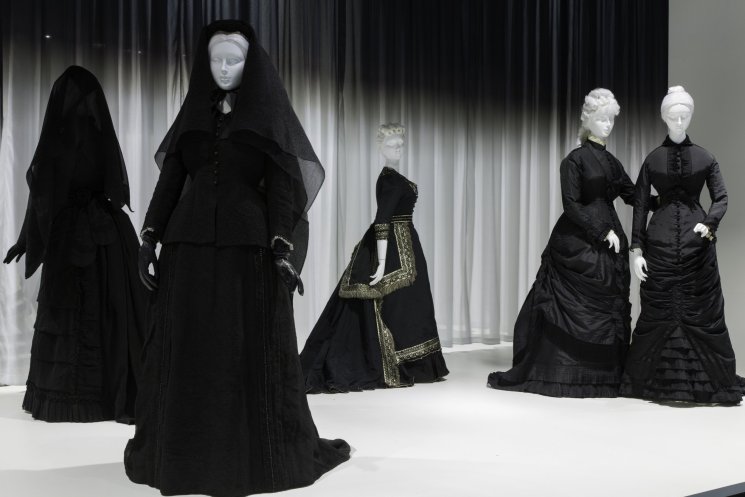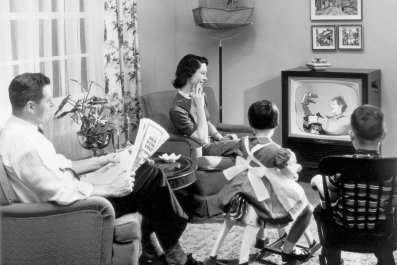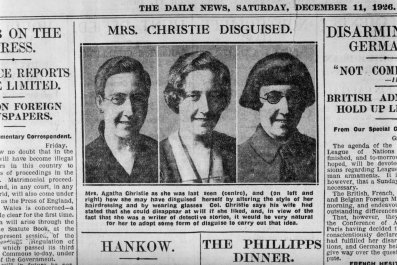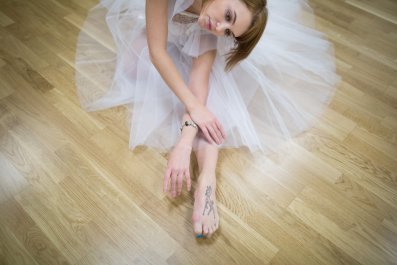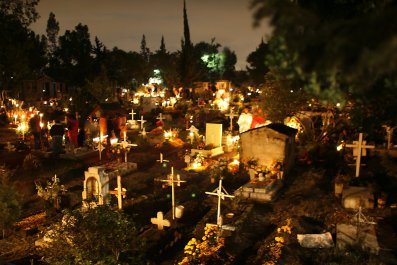Before finding comfort in therapy became a common practice, many grieving women found comfort in black dresses.
Clothing themselves in deep black for a year following the death of their husbands was, for many widows in 19th century America, an important expression of grief and respect, as well as a sign of taste, class, and propriety.
A new exhibit by the Metropolitan Museum of Art's Costume Institute in Manhattan, which opened Tuesday in the Anna Wintour Costume Center, traces the rituals of mourning attire from 1815 to 1915. Titled "Death Becomes Her: A Century of Mourning Attire," the exhibit explores the intersection of high fashion and bereavement at its peak. It runs through February 1, 2015.
"For one woman [mourning attire] might seem especially meaningful. For another it was simply a social obligation, a way of confirming one's respectability as well as honoring the loss," Jessica Regan, assistant curator for the exhibition, tells Newsweek. It was a "fine line to balance conforming to these standards and respecting the deceased but not going so far as to seem insincere or inappropriately ostentatious."
After walking through the lobby and past the museum's walls of ancient Egyptian art, visitors are presented with a stark white stairway leading to the Costume Institute exhibit, decorated with tall weeping willows, painted pitch black. The willows, the exhibit downstairs reveals, were one of several symbols traditionally depicted on mourning jewelry in the 19th century, along with urns, tombstones and clouds.
Inside the Anna Wintour Costume Center, named for the influential and longtime editor-in-chief of fashion bible American Vogue, mannequins stand on a raised white dais with large wigs swept up in intricate hairstyles, carefully posed with nuanced hand gestures and downward gazes.
The mannequins are dressed in elaborate attire made primarily of muted black fabrics. Some incorporate more illustrious black fabrics and the gray and mauve that were considered appropriate for "half mourning," which followed the initial period in black.
Projected quotes appear in bright white letters on the shadowy walls and then fade slowly away as Gabriel Fauré's 1893 Requiem plays softly in the background.
One quote, from Edith Wharton's New Year's Day (The Seventies), reads:
She was beginning to find that everyone had an air of remoteness; she seemed to see people and life through the confusing blur of the long crape veil in which it was a widow's duty to shroud her affliction.
Another, from the 1881 Gems of Deportment and Hints on Etiquette by M.L. Rayne, reads:
Her deportment should be grave and discreet, particularly in the presence of gentlemen, who will seek her society; as there is a charm and fascination in the manner and conversation of a widow which is known and appreciated by the other sex.
Semi-sheer white curtains hang from above to separate the mannequins into chronological order, illustrating the evolution of the fashion silhouette throughout the 19th century and the impact of fashion ideals on rituals of mourning.
The period in question—1815 through 1915—saw the tradition of mourning attire sweep through society, says Regan. Industrialization and mechanization of the textile industry starting at the end of the 18th century allowed for mass production and made more fabrics available to the middle class, while chemical dyes introduced in the 1860s made black fabrics more affordable.
At the same time, the fashion magazine flourished—with Harper's Bazaar publishing its first issue in 1867 and Vogue following in 1892, among others—offering middle-class women detailed descriptions and advice on mourning attire. American department stores all had mourning departments and some larger scale retail stores specialized only in mourning goods, Regan says. Women could also order mourning attire from private dressmakers or couture houses, while the less affluent could purchase secondhand dresses or dye existing dresses black.

"Modes of mourning that had been the preserve of the elite were made available to the burgeoning middle class," reads the exhibit's introductory text.Of the mannequins perched on the white platform, the vast majority are women.
"The responsibilities of mourning were largely placed on women, who were essentially seen as representatives of their family," Regan tells Newsweek. "They were expressing their family's collective sense of grief and respect for a loved one."
Men on the other hand, didn't have much of an obligation to change their attire—which was usually already composed primarily of black or dark colors. A dark hatband or black cufflinks might suffice for a man, Regan says.
The gap in expectations extended far beyond clothing, says Harold Koda, the curator of the Costume Institute, who worked with Regan to prepare the exhibit. Men could remarry within one month, Koda says, whereas women were expected to spend a year in full mourning. Poor widows in particular would have lost economic power and protection along with a husband.
"The veiled widow could elicit sympathy as well as predatory male advances," Koda is quoted as saying in a museum press release. "As a woman of sexual experience without marital constraints, she was often imagined as a potential threat to the social order."
Though fashion magazines and advice manuals often presented strict guidelines, individual women interpreted them on a spectrum, determining the types of fabrics she used or the length of time she remained in mourning attire as she saw fit.
The mourning attire that flourished in the 19th century didn't survive long into the 20th. World War I accelerated the decline of these rituals, Regan tells Newsweek, explaining why the war marks the end of the show's chronology. With so many losses suffered, and women working outside the home and engaging in the war effort, "standards no longer felt relevant or practical," she says.
"Women felt, and rightly, that the indulgence of personal grief, even to the extent of wearing mourning, was incompatible with their duty to themselves, to their country, and to the men who cheerfully laid down their lives," reads a quote from American Vogue in 1918, projected on one wall of the exhibition space.
"Ritual practice helps us give form to something that you can't really articulate," Koda tells Newsweek. But the practices on display in Death Becomes Her, he says, are signifiers of loss that have been left behind in the last century.
The show "will feed into the beauty of mourning, but this is about codifying stages of grief," Koda says. "If you've lost someone, it's not glamorous."




